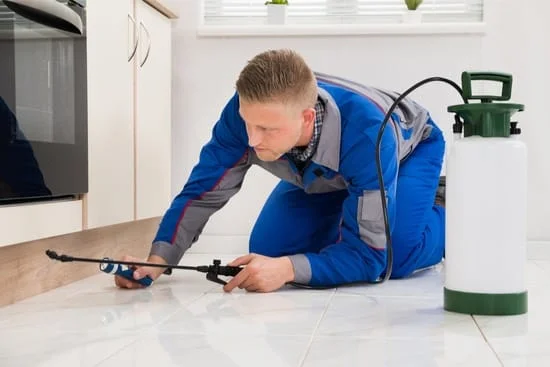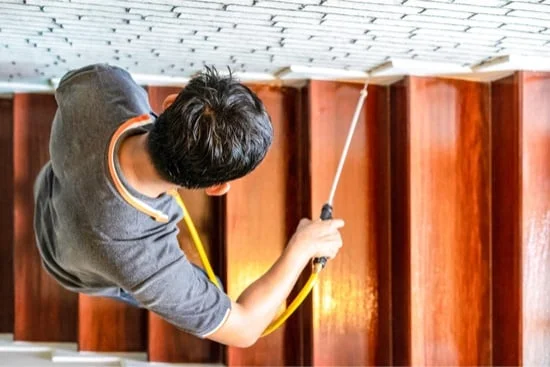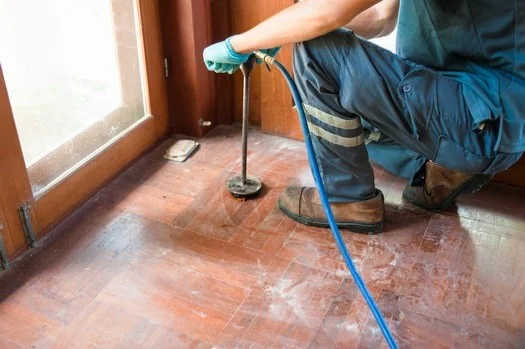Bed bugs are notoriously difficult to kill. That’s in part because they pick hiding spots around the room, not just in your bedding. That’s why you might find bed bugs in wood flooring.
Bed bugs may infest wood floors if they can find a spot to hide from sunlight. Floorboards with cracks in them, especially under the bed, make good bed bug harborages. However, bed bugs are far more likely to live in your mattress and bedding.
Bed bugs in floor cracks are easy to get rid of if you know how. We’ll explain exactly why bed bugs like wood floors, and how you can tell if your flooring is infested. We’ll then advise you how to get rid of bed bugs in hardwood floors.
Can Bed Bugs Infest Wood Floors?
Bed bugs can infest wood floors, provided they can access you to feed.
Bed bug infestations start when a female finds their way into your house. Bed bugs can’t reproduce asexually, i.e., without a male and a female. But after mating, the female can lay eggs for weeks.
If you bring one of these females home, she’ll start an infestation on her own. She’ll search out a place that’s dark and hidden, where she’ll be safe for the time being.
Wooden flooring is perfect for that. At night, she’ll seek out the warmth of your body and the CO2 you breathe out.
After she feeds, she’ll find a secure place that has lots of hidden cracks to lay eggs in. She’ll typically pick the underside of your mattress. However, she may choose somewhere else, like the cracks between wooden floorboards.
In a severe infestation, the likelihood of the floor being infested increases. Egg-laying females will venture out from their existing harborages, to search for somewhere to lay their eggs. The more females, the higher the chance they’ll move to the floor.
Can Bed Bugs Crawl on the Floor?
Bed bugs can crawl on the floor, but will usually choose not to. They scuttle along in a way that’s similar to other bugs. They move slowly, but speed up if they’re disturbed. They don’t fly, and bed bugs can’t jump, just crawl.
They spend most of their time in your bedding, i.e., your mattress, sheets and perhaps your pillow. When you’re not there, they’ll digest, mate, or sit and wait. When you return, they may feed.
Only a few bed bugs will ever crawl on the floor. These are:
- Bugs that have only just been introduced to the home
- Bugs that live outside of your bedding, e.g., in furniture or the floor
- Female bugs that are searching for somewhere new to lay their eggs
You’ll only see some of the infestation on the floor. To see how big it is, check under your mattress.
Do Bed Bugs Eat Wood?
Bed bugs only feed on blood. They feed on people, but can feed on other animals when necessary.
Bed bugs can’t eat wood, fabric or anything similar. Other bugs do, but bed bugs don’t. They don’t have the right mouthparts to do so. They have a long straw like mosquitoes do, and can’t chew.
Besides, bed bugs have never lived in areas where there are trees. They evolved from bat bugs, which used to (and still) live in caves. Today’s bed bugs never venture outside, and will eventually starve if they do, as they can’t find food.
Why Do Bed Bugs Live in Wood Floors?
While bed bugs are small, they are smart, at least in certain ways. They look for many things when they search for their ideal harborage. Bed bug hiding places are usually:
- Close to humans. Bed bugs prefer to live within six feet of their host’s sleeping place. This means that the flooring under your bed is within range.
- A certain color. Bed bugs prefer dark black and red spaces, since these are typically in shadow. The cracks between floorboards are the right color for them.
- Hidden away. Bed bugs are photophobic, meaning that they scatter when they see light. Cracks in wooden flooring allow them to escape light easily.
Aside from that, bed bugs aren’t picky. They’ll live anywhere that meets these criteria.
They may also choose to live somewhere else that’s wooden. Examples include inside, behind and underneath furniture, or behind the baseboard.

Can Bed Bugs Burrow into Wood?
Just because bed bugs can live in wood, that doesn’t mean they know how to burrow.
Burrowing bugs eat their way into wood or other materials using their strong jaws. The holes they make provide safe resting places, while also being a source of food.
Bed bugs don’t have strong jaws, just a fascicle (drinking straw). They also don’t have strong legs, which they could hypothetically burrow with. Instead, they find a crack and live inside that.
There are opportunities for bed bugs to find harborages without them having to burrow. If bugs are burrowing into your wooden flooring, it’s most likely termites, carpenter ants or powderpost beetles.
Does Wood Attract Bed Bugs?
Bed bugs are attracted to three things. These are:
- Carbon dioxide (CO2)
- Heat, especially the temperature of body heat
- The natural smell of skin
Carbon dioxide and heat especially are used in bed bug lures. There’s nothing in wood that attracts them in the same way.
That being said, wood does have several qualities that make it an appropriate harborage. So while it doesn’t attract them, it does make a good home.
How Do Bed Bugs Get Under Carpet?
If you have a carpet or rug on top of your wooden flooring, there isn’t a good way for them to get underneath. They may try to get in the gap between the carpet and the wall.
Bed bugs don’t naturally hide deep inside things. They hide, but only so much, so they can access you easily. Once they find the gap between the carpet and the wall, they won’t want to keep going to get underneath.
The only exception is if the carpet covering your wood flooring has completely come away from the wall. If that’s the case, and there’s a flap that reveals the floor underneath, then they could easily infest the floor there. Many people mistake bed bugs for carpet beetles.
How Can You Find Bed Bugs in Wood Flooring?
Finding bed bugs is always tough, because they have an innate desire to avoid you. To spot bed bugs, you have to know how to identify bed bugs. They are as follows:
- The same size as an apple seed
- Somewhere between brown and black
- Flat-bodied but wide
You may only see their backside poking out from the crack, though.
To find them, start by sealing off the area you’re looking at. By disturbing them, you encourage them to move around the room. A simple physical barrier like a fabric draft stopper would be fine.
Once the exits are sealed, start your search. Get down on your knees to check each crack.
To examine each one thoroughly, you could take a knife and run it along the crack. This may encourage any hidden bed bugs to try and scuttle away.
How to Get Rid of Bed Bugs in Hardwood Floors
Getting rid of bed bugs normally takes a long time. That’s especially the case if they’re hidden around the room, in your bedding, floor, and furniture.

Let’s briefly look at how you can get rid of them, or at least stop them biting you.
1) Best Bed Bug Floor Barrier
There are a few ways to stop bed bugs from being able to access the floor.
You could fit a carpet or linoleum instead of wooden flooring. Wooden flooring might be nicer, but it’s better for bed bugs to hide in.
If you like your wooden floor, consider filling in any large gaps or cracks. Clean the cracks and fill them with wood putty.
You can also stop the bed bugs in your floor from getting into your bed. To do so, you’ll need interceptors. Bed bug interceptors sit around the feet of your bed or other furniture. They are made from plastic which they can climb into, but not out of.
Bed bugs get trapped in a small well inside the interceptor. The well may be filled with water, in which case they will drown or they get stuck. Either way, they can’t get to you to feed.
These interceptors are a cheap and reliable way to kill bed bugs. They stop any bed bugs that you bring home from being able to infest your bedding.
2) Using Sprays to Kill Bed Bugs
A favorite way of killing bed bugs is using sprays. Insecticidal sprays linger after use, killing the infestation over a few weeks.
Wooden floors are easy to spray, because you can see every crack and crevice. All you have to do is spray them all. Even if the bugs hide, they’ll die when they come into contact with the leftover chemicals.
Sprays have the added benefit of killing nymphs soon after they hatch. They also repel bugs hiding elsewhere around the room from crossing the floor to try and find you.
3) Bed Bug Heat Treatment
A great way to kill bed bugs is with heat treatment. Bed bugs are susceptible to heat, even more so than to pesticides.
Heat treatment requires an exterminator. The idea is to raise the temperature higher than 122 degrees, preferably at least 140. At these temperatures, bed bugs die within minutes.
According to PLoS One, heat treatment has one more advantage. Bed bugs can’t become immune to it as they can to pesticides.
Failing that, you could hire a heat treatment machine. These are difficult to find and for a beginner to use. Either way, heat treatment is the best way to kill bed bugs in floors.
Best Flooring to Prevent Bed Bugs
Flat flooring with no cracks offers far fewer places for bed bugs to hide. Carpet is, therefore, better than wooden flooring in this regard.
Thicker carpet is also more difficult for them to walk over. However, the main drawback is that bed bugs can be difficult to see on the carpet.
Whatever flooring you have, it has to reach to the edge of the floor. If there’s a gap between the flooring and the wall, bed bugs can hide there.
Can Bed Bugs Live in Laminate Flooring?
Bed bugs can’t live in laminate flooring, since it’s flat. Even with grooves running along it, those ridges aren’t deep enough for bed bugs to hide in.
The only exception is if it doesn’t reach the wall. Bed bugs love to hide inside cracks, particularly around the edges of a room and in the cracks of walls.
However, getting your flooring replaced is not a priority. Even if you did, it wouldn’t get rid of your infestation. The bed bugs would find somewhere else to live, instead.
A far more effective method is to hire an exterminator, especially for heat treatment. They’ll heat your entire home, killing the bugs wherever they’re hiding.
Failing that, pesticides or store-bought bed bug sprays are a reasonable alternative.


Hi
I am having problems with Bed Bug l have ripped the carpet in my bedroom l have had to buy 3 new bed and new mattresses in the last 2 year l can’t afford to do it again l am currently sleeping downstairs in a blow up air bed as l keep getting bite up everytime.l sleep in my bed and sleeping on air bed is killing my back off and all l want to do is sleep in my own bed what can l do l have cracks in my floor boards